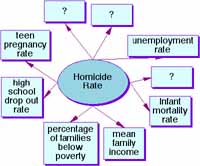|
Enjoy Jamie McKenzie's book, Planning Good Change. Click here to learn more. |
 From Now On
From Now On
The Educational Technology Journal
Special Summer 2000 Issue

The Ties that Bind
and the Links
that Set Us Free
Coherence provides the ties that bind information into intelligible packages and the links of meaning that set us free.
Despite all the dot.com hype and promises, we are discovering that vastly increased access to information does not automatically translate into more perceptive insights, wiser decisions or sharper thinking.
A few decades ago we lamented the shortage of current information. Now we may drown in infoglut - oceans of unreliable and undifferentiated data that often confound and confuse rather than illuminate. We suffer from noise. We search for relief. We need help!

We need something far more musical - information combining harmoniously to deliver a melody, a song, a message or a meaning.
Noise is a bother when we seek insight. Noise brings us chaos . . . static . . . bedlam . . . cacophony. Noise offers distraction, distortion and distress.

This article will focus on the importance of achieving coherence in the face of information abundance. Coherence supplies the ties that bind information into intelligible packages and the links of meaning that set us free.
The article will also explore the essential roles of public librarians, school librarians and others as they help young people and elders find their ways across this daunting new information landscape. Too little has been written about moving beyond information to understanding. Too few have acknowledged the dangers of eliminating information support services during a time of information flooding.
These are times to avoid undue reliance upon wizards, templates and artificial intelligence, against naive embracing of knowbots and so-called "intelligent agents." We continue to see that human questions and exploration usually respond best to (live) human assistance.
Why is coherence so important? and so elusive?
We are bombarded by fragments and datasets that overwhelm us like a swarm of locusts. They fog our windshields and our eyeglasses - our spyglasses, magnifying glasses or microscopes. We find unbridled abundance blinding. Infoglut threatens us with a kind of intellectual imprisonment.
It is almost as if we have been thrown into one of those huge bouncing playpens you see at fast food restaurants - this one all filled up with jangling jigsaw pieces. It is nearly impossible to put the pieces together, but there is plenty of action, great excitement and lots of flash. We are wired!
- But what does it all mean?
- How do we make sense of the nonsense?
- How do we turn down the volume to focus on the important information?
- How can we reduce time wasted wandering about?
- How do we find the right stuff? filter out the extraneous? the unreliable?
We can download crime statistics, but that action, in itself, does not mean we understand crime or its causes.
- US Bureau of Justice (http://www.ojp.usdoj.gov/bjs/dtdata.htm)
- Stats Canada (http://www.statcan.ca/english/Pgdb/)
- Australian Institute of Criminology (http://www.aic.gov.au/stats/index.html)
- Statistics New Zealand (http://www.stats.govt.nz/b1statsnz.htm)


Downloading and collecting is a just a preliminary stage.
It is only when we explore relationships between variables and seek cause-and-effect possibilities that we begin to approach understanding.
When we ask how the numbers, the facts and the information "fit together." we are seeking coherence.
Which of the following variables are most strongly correlated with the homicide rates of large American cities?
- infant mortality rate
- high school drop out rate
- teen pregnancy rate
- unemployment rate
- mean family income
- percentage of families below poverty level

If they are correlated, what does that mean? Is there a causal relationship?
What are the implications for policy?
New Curriculum Standards Require Different Research Models
With the old-fashioned topical school research, students did little more than gather - cut and paste the facts already organized by someone else.
- Raw materials?
- Customs?
- Politics?
- Products?
- Climate?
Coherence was supplied by the information provider and built into the heavily structured report format demanded by Mr./Mrs. Smith:
Raw Materials
.
Customs
.
Politics
.
Religion
.
Products
.
Climate
.
History
.
Geography
.
The encyclopedia and Ms./Dr. Smith teamed to deliver coherence, requiring nothing more from students than pigeonholing. As long as they listed temperatures in the right box, they could create the appearance of coherence, but they were not struggling with an authentic coherence task.
The old system was too much like "paint by numbers." This was coherence by proxy.
What has changed?
State curriculum standards require far more thinking from students. North Carolina science standards require mastery of the following integrated process skills, for example:
- acquiring, processing, and interpreting data.
- identifying variables and their relationships.
- designing investigations.
- experimenting.
- analyzing investigations.
- constructing hypotheses.
- formulating models.
School research is shifting toward problems-based inquiry demanding fresh thinking about real problems and choices. These problems are ripe with surprise, confusion and conflict.
- "What should we do with the Snake River?"
- "What should we do about gambling in our state?"
- "Which city is most likely to provide me with an exciting life filled with great opportunities, well being, safety and decent weather?"
- "Which Captain would be the best leader?"
- "Which writer, painter, or composer used color most vividly and how could I change my own writing, painting or musical composition to take advantage of such techniques?"

When students begin their search on such questions, the vast amount of information assaults them with the force and the volume of a Tsunami wave as hundreds of articles scream down the Internet highway onto the student desktop. Take, for example, this listing of Web sites and articles collected to cast light on an environmental issue . . .
"What should we do with the Snake River?"
How can we begin to make sense of all this information?
The information is overwhelming, unless we have been well taught by those who understand information literacy and the skills required to bring order and meaning to this hodge podge. Confronted by so much data, information, opinion, speculation, blather, propaganda, chat and distortion, we learn that literacy skills are actually survival skills.
Literacy skills lead us to coherence and connectedness. They set us free from undue reliance on others to interpret for us. They make it possible for students to develop independent views. They reduce dependencies.
The ability to find the linkages, the connections, the consequentiality and the clarity associated with coherence is the result of conscious, explicit instruction by good teachers and teacher librarians - an approach that will be outlined later in this article.
In exploring concepts related to coherence, the thesaurus provided a long list of words from which I selected 15 to share below. To enhance their meaning, I displayed them in a table and moved them around into groupings that made some sense. They were already linked by being nouns, but I could distinguish at least five different categories or strands. I emphasized these by leaving blanks between groups, by changing colors and by selecting one word in each group to stand as a heading. Once grouped, I was able to form an explanation of how each might contribute to coherence, all of which are listed in the second table.
My movement and organizing of the concepts increased my understanding of coherence.
Aspects
of Coherence
connectedness
logic
intelligibility
linkages
chains
unity
series
consolidation
clarity
cohesion
coalescence
clearness
connection
consequentiality
lucidity
Category 1
Connectedness
Coherence is enhanced by noting the linkages, connections, similarities and shared traits of ideas, information and concepts as well as any opposites and contrasts. We look for fit and match.
Category 2
Logic
Coherence is enhanced by considering the way ideas are related in terms of meaning, as in the way that details and evidence serve like the supporting beams of a main idea, conclusion or theory.
Category 3
Unity
Coherence is enhanced by resolving contrasts, conflicts and dissonance into harmony, resonance and agreement, by eliminating rough edges, inconsistencies and contradictions.
Category 4
Clarity
Coherence is enhanced by reducing distractions, emphasizing pertinent ideas and facts, optimizing focus and minimizing fog, distortion and irrelevancies.
Category 5
Intelligibility
Coherence is enhanced by translation of complex and difficult concepts into terms that are easier to digest, grasp and comprehend, recognizing that a picture or chart may be worth a thousand words or ten thousand data points, looking for powerful metaphors, avoiding jargon and relying upon the power of story telling to put across very challenging ideas.
Thinking back to the long list of online resources related to the Snake River, what organizing strategies could be applied to the list so that it provides coherence? How could the list be organized to deliver greater connectedness, logic, unity, clarity and intelligibility?
The first step might be to identify the main traits of each resource so they can be grouped and annotated. This grouping and annotating would dramatically enhance the intelligibility of the list. Try this example on your students. Can they sort, sift and arrange the sites to fit where they belong?
A variation of this challenge is to develop a new framework of categories quite different from the one supplied above.
The Power of Definitions
To further our understanding of coherence, we can explore other forms of the word such as the adjective, coherent. The dictionary helps us to identify the qualities of research and writing that might deserve such an accolade.
Coherent
1. Sticking together; cohering. 2. Marked by an orderly, logical, and aesthetically consistent relation of parts: "a coherent essay."
The American Heritage® Dictionary
of the English Language: Third Edition. 1996.
An investment in coherence leads to findings, conclusions and discoveries that are intelligible. It is not enough to collect a huge mountain of facts and figures. They must be sorted and sifted, organized and rearranged so that they mean something. They must be condensed, simplified, summarized, interpreted and analyzed so that significance comes to the foreground.
If our students are successful in their organizing and thinking, their presentations, reports, performances or lobbying efforts will be worthy of the term coherent.
coherent
intelligible
manifest
clear
discoverable
unequivocal
unblurred
cognizable
unambiguous
distinct
knowable
clear-cut
precise
explicable
lucid
teachable
logical
meaningful
By shifting from the noun coherence to the adjective coherent, we end up with two new categories. We still have issues of logic, clarity and intelligibility, but now we have additional questions related to the effectiveness of our communication. Is the work, the writing, the thinking and the presenting explicable and teachable? Are the discoveries made by the researcher/student manifest? Can those who are untutored in the issue at hand find meaning that is unequivocal and unambiguous? Were findings shared lucidly so that insight is discoverable?
We don't really care how many thousands of numbers have been collected. We want to know which city is safest without plowing through piles of data. Are the findings clear, compelling and easily shared with others?
We are not impressed by a huge assortment of editorials, opinions, rants and shouts or various tempers and tones. We hope to emerge with some wisdom, some well reasoned thinking that casts light on what we should do with the Snake River or the river that runs through our own back yard.
Providing Support for Coherence throughout the Research Process
© 2000 Jamie McKenzie
about the author
Credits: The photographs were shot by Jamie McKenzie.
Copyright Policy: Materials published in From Now On may be duplicated in hard copy format if unchanged in format and content for educational, nonprofit school district and university use only and may also be sent from person to person by e-mail. This copyright statement must be included. All other uses, transmissions and duplications are prohibited unless permission is granted expressly. Showing these pages remotely through frames is not permitted.
FNO is applying for formal copyright registration for articles.
Despite all the dot.com hype and promises, we are discovering that vastly increased access to information does not automatically translate into more perceptive insights, wiser decisions or sharper thinking. A few decades ago we lamented the shortage of current information. Now we may drown in infoglut - oceans of unreliable and undifferentiated data that often confound and confuse rather than illuminate. We suffer from noise. We search for relief. We need help!
This article will focus on the importance of achieving coherence in the face of information abundance. Coherence supplies the ties that bind information into intelligible packages and the links of meaning that set us free. The article will also explore the essential roles of public librarians, school librarians and others as they help young people and elders find their ways across this daunting new information landscape. Too little has been written about moving beyond information to understanding. Too few have acknowledged the dangers of eliminating information support services during a time of information flooding. These are times to avoid undue reliance upon wizards, templates and artificial intelligence, against naive embracing of knowbots and so-called "intelligent agents." We continue to see that human questions and exploration usually respond best to (live) human assistance. Why is coherence so important? and so elusive? We are bombarded by fragments and datasets that overwhelm us like a swarm of locusts. They fog our windshields and our eyeglasses - our spyglasses, magnifying glasses or microscopes. We find unbridled abundance blinding. Infoglut threatens us with a kind of intellectual imprisonment. It is almost as if we have been thrown into one of those huge bouncing playpens you see at fast food restaurants - this one all filled up with jangling jigsaw pieces. It is nearly impossible to put the pieces together, but there is plenty of action, great excitement and lots of flash. We are wired!
We can download crime statistics, but that action, in itself, does not mean we understand crime or its causes.
New Curriculum Standards Require Different Research Models With the old-fashioned topical school research, students did little more than gather - cut and paste the facts already organized by someone else.
Coherence was supplied by the information provider and built into the heavily structured report format demanded by Mr./Mrs. Smith:
The encyclopedia and Ms./Dr. Smith teamed to deliver coherence, requiring nothing more from students than pigeonholing. As long as they listed temperatures in the right box, they could create the appearance of coherence, but they were not struggling with an authentic coherence task. The old system was too much like "paint by numbers." This was coherence by proxy. What has changed? State curriculum standards require far more thinking from students. North Carolina science standards require mastery of the following integrated process skills, for example:
School research is shifting toward problems-based inquiry demanding fresh thinking about real problems and choices. These problems are ripe with surprise, confusion and conflict.
The information is overwhelming, unless we have been well taught by those who understand information literacy and the skills required to bring order and meaning to this hodge podge. Confronted by so much data, information, opinion, speculation, blather, propaganda, chat and distortion, we learn that literacy skills are actually survival skills. Literacy skills lead us to coherence and connectedness. They set us free from undue reliance on others to interpret for us. They make it possible for students to develop independent views. They reduce dependencies. The ability to find the linkages, the connections, the consequentiality and the clarity associated with coherence is the result of conscious, explicit instruction by good teachers and teacher librarians - an approach that will be outlined later in this article. In exploring concepts related to coherence, the thesaurus provided a long list of words from which I selected 15 to share below. To enhance their meaning, I displayed them in a table and moved them around into groupings that made some sense. They were already linked by being nouns, but I could distinguish at least five different categories or strands. I emphasized these by leaving blanks between groups, by changing colors and by selecting one word in each group to stand as a heading. Once grouped, I was able to form an explanation of how each might contribute to coherence, all of which are listed in the second table. My movement and organizing of the concepts increased my understanding of coherence.
Thinking back to the long list of online resources related to the Snake River, what organizing strategies could be applied to the list so that it provides coherence? How could the list be organized to deliver greater connectedness, logic, unity, clarity and intelligibility? The first step might be to identify the main traits of each resource so they can be grouped and annotated. This grouping and annotating would dramatically enhance the intelligibility of the list. Try this example on your students. Can they sort, sift and arrange the sites to fit where they belong?
A variation of this challenge is to develop a new framework of categories quite different from the one supplied above. The Power of Definitions To further our understanding of coherence, we can explore other forms of the word such as the adjective, coherent. The dictionary helps us to identify the qualities of research and writing that might deserve such an accolade.
An investment in coherence leads to findings, conclusions and discoveries that are intelligible. It is not enough to collect a huge mountain of facts and figures. They must be sorted and sifted, organized and rearranged so that they mean something. They must be condensed, simplified, summarized, interpreted and analyzed so that significance comes to the foreground. If our students are successful in their organizing and thinking, their presentations, reports, performances or lobbying efforts will be worthy of the term coherent.
By shifting from the noun coherence to the adjective coherent, we end up with two new categories. We still have issues of logic, clarity and intelligibility, but now we have additional questions related to the effectiveness of our communication. Is the work, the writing, the thinking and the presenting explicable and teachable? Are the discoveries made by the researcher/student manifest? Can those who are untutored in the issue at hand find meaning that is unequivocal and unambiguous? Were findings shared lucidly so that insight is discoverable? We don't really care how many thousands of numbers have been collected. We want to know which city is safest without plowing through piles of data. Are the findings clear, compelling and easily shared with others? We are not impressed by a huge assortment of editorials, opinions, rants and shouts or various tempers and tones. We hope to emerge with some wisdom, some well reasoned thinking that casts light on what we should do with the Snake River or the river that runs through our own back yard. Providing Support for Coherence throughout the Research Process
© 2000 Jamie McKenzie
|
Credits: The photographs were shot by Jamie McKenzie.
Copyright Policy: Materials published in From Now On may be duplicated in hard copy format if unchanged in format and content for educational, nonprofit school district and university use only and may also be sent from person to person by e-mail. This copyright statement must be included. All other uses, transmissions and duplications are prohibited unless permission is granted expressly. Showing these pages remotely through frames is not permitted.
FNO is applying for formal copyright registration for articles.
